Facility Description
The Aquatic Animal Research Laboratory CORE facility is a 4000 sf facility comprised of 12 animal rooms, a zebrafish quarantine laboratory, a general washroom, a water quality and procedural laboratory, and a microscopy laboratory for embryo injections, imaging, sorting, and incubation.
-
Animal Rooms
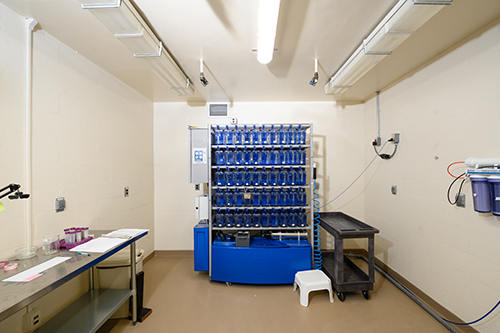 Animal rooms are approximately 225 sf (12x20’). Rooms are outfitted with a wash sink, centrally located floor drains, personnel lights, and a computerized LED animal lighting system. Each animal room has 2-4 dedicated 20 amp circuits with backup power, and an additional 4-6 dedicated 20 amp circuits. Backup power is provided by a diesel generator serviced through Clemson Facilities.
Animal rooms are approximately 225 sf (12x20’). Rooms are outfitted with a wash sink, centrally located floor drains, personnel lights, and a computerized LED animal lighting system. Each animal room has 2-4 dedicated 20 amp circuits with backup power, and an additional 4-6 dedicated 20 amp circuits. Backup power is provided by a diesel generator serviced through Clemson Facilities. -
Wash Room
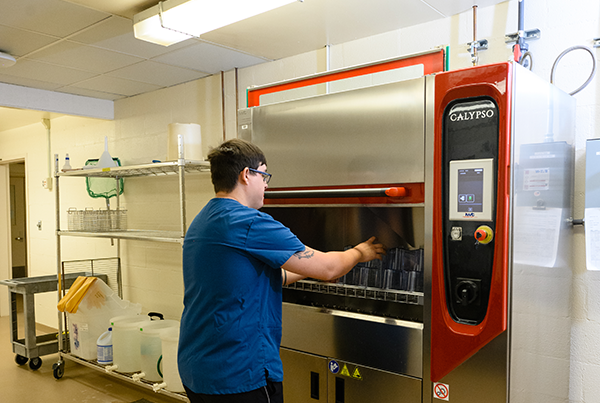 The washroom has an oversized sink for scrubbing tanks and large objects. Plastic totes and bleach is provided for tanks, nets, and miscellaneous equipment sanitation. There is a dedicated small tank washer from Tecniplast that can wash up to twelve 3.5 liter zebrafish style tanks per 25 minute cycle. There are dedicated freezers in the washroom for carcass disposal and food storage.
The washroom has an oversized sink for scrubbing tanks and large objects. Plastic totes and bleach is provided for tanks, nets, and miscellaneous equipment sanitation. There is a dedicated small tank washer from Tecniplast that can wash up to twelve 3.5 liter zebrafish style tanks per 25 minute cycle. There are dedicated freezers in the washroom for carcass disposal and food storage. -
Water Quality
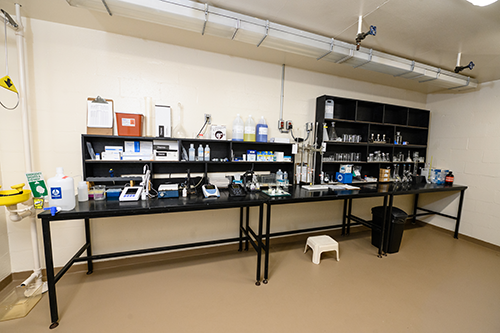 The water quality laboratory is open for all facility users. Bench top pH and conductivity meters are available to test or verify inline aquatic system water quality probe values. A titration station is set up for alkalinity and hardness determinations. API colorimetric test kits are provided for nitrogen speciation determination. Several balances are on hand for weighing out salts or taking precise measurements. Select water quality salts are available along with MS-222 for euthanizing aquatic organisms. The water quality lab can also be used for dissection, necropsy, or other required procedures.
The water quality laboratory is open for all facility users. Bench top pH and conductivity meters are available to test or verify inline aquatic system water quality probe values. A titration station is set up for alkalinity and hardness determinations. API colorimetric test kits are provided for nitrogen speciation determination. Several balances are on hand for weighing out salts or taking precise measurements. Select water quality salts are available along with MS-222 for euthanizing aquatic organisms. The water quality lab can also be used for dissection, necropsy, or other required procedures. -
Microscopy Laboratory and Injection Room
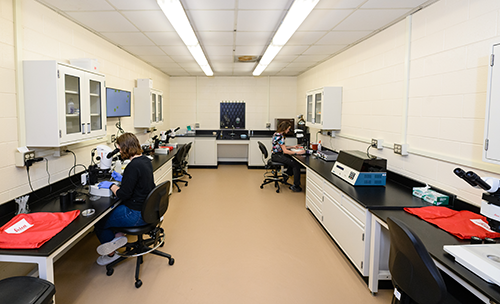 The microscopy laboratory is outfitted with three Leica S9i stereomicroscopes. One is equipped with a color camera and hooked up to a 36” TV monitor for training and student observation. Two Leica M80 stereomicroscopes are set up specifically for embryo injections. The injection workstations use a Nirishege MN-151 joystick micromanipulator combined with either a Harvard Apparatus BTX Microject 1000A, or a MinJ-D all digital microinjector by TriTech Research. One of the injection stations is outfitted with a camera and a video monitor for training and student observation. Also housed in the microscopy laboratory is a Leica M165 fluorescence microscope using the LAX operating system with mCherry, GFP, and GFP LP filters.
The microscopy laboratory is outfitted with three Leica S9i stereomicroscopes. One is equipped with a color camera and hooked up to a 36” TV monitor for training and student observation. Two Leica M80 stereomicroscopes are set up specifically for embryo injections. The injection workstations use a Nirishege MN-151 joystick micromanipulator combined with either a Harvard Apparatus BTX Microject 1000A, or a MinJ-D all digital microinjector by TriTech Research. One of the injection stations is outfitted with a camera and a video monitor for training and student observation. Also housed in the microscopy laboratory is a Leica M165 fluorescence microscope using the LAX operating system with mCherry, GFP, and GFP LP filters. -
Growth Chamber and Incubators
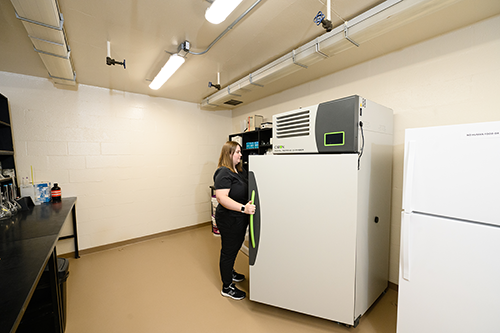 Two small bench top Yamato convection type incubators with a viewing window are available for embryo incubation. Normal temperature is set at 28’ C. A larger Caron 25 cubic foot growth chamber is also available for embryos. This is a closed system with internal narrow range (400-500 nm) lighting system and a 24 hour timer for day/night simulation. The Caron growth chamber is a chiller or an incubator with a temperature range of 10-40C.
Two small bench top Yamato convection type incubators with a viewing window are available for embryo incubation. Normal temperature is set at 28’ C. A larger Caron 25 cubic foot growth chamber is also available for embryos. This is a closed system with internal narrow range (400-500 nm) lighting system and a 24 hour timer for day/night simulation. The Caron growth chamber is a chiller or an incubator with a temperature range of 10-40C. -
Water Source and Purification
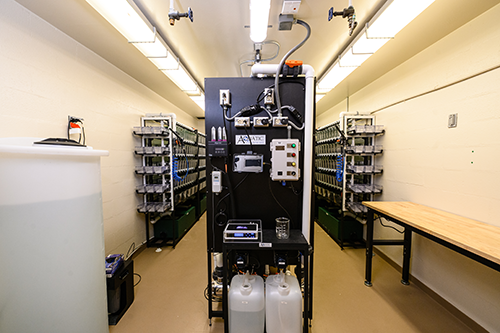 Water is sourced from the Anderson Regional Joint Water System and comes into the facility with a chlorine concentration of 1 mg/l. Water purification for culture and animal use is performed at the room level. Water is purified through a process of sediment and carbon filtration, followed by reverse osmosis.
Water is sourced from the Anderson Regional Joint Water System and comes into the facility with a chlorine concentration of 1 mg/l. Water purification for culture and animal use is performed at the room level. Water is purified through a process of sediment and carbon filtration, followed by reverse osmosis.
